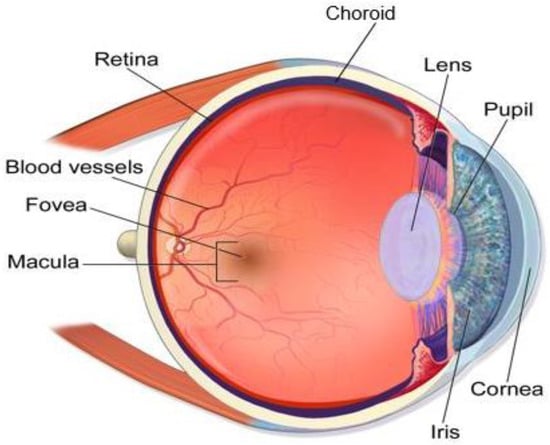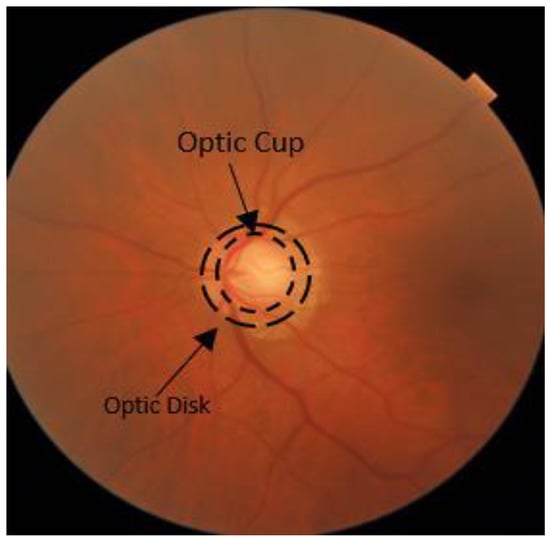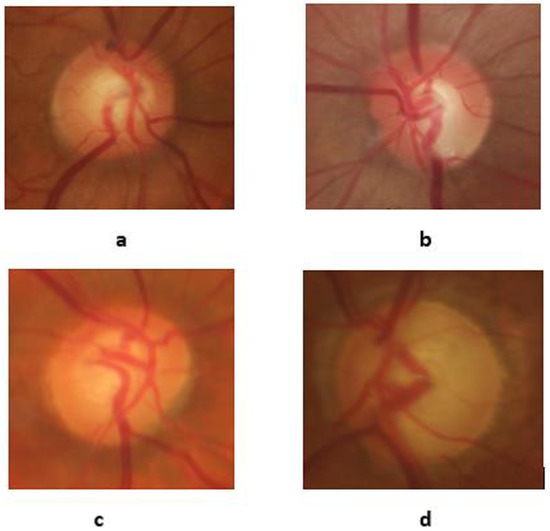Glaucoma is characterized by increased intraocular pressure and damage to the optic nerve, which may result in irreversible blindness. The drastic effects of this disease can be avoided if it is detected at an early stage. However, the condition is frequently detected at an advanced stage in the elderly population. Therefore, early-stage detection may save patients from irreversible vision loss. The manual assessment of glaucoma by ophthalmologists includes various skill-oriented, costly, and time-consuming methods. Several techniques are in experimental stages to detect early-stage glaucoma, but a definite diagnostic technique remains elusive. The detection technique involves the identification of patterns from the retinal images that are often overlooked by clinicians. The proposed approach uses the gray channels of fundus images and applies the data augmentation technique to create a large dataset of versatile fundus images to train the convolutional neural network model. Using the ResNet-50 architecture, the proposed approach achieved excellent results for detecting glaucoma on the G1020, RIM-ONE, ORIGA, and DRISHTI-GS datasets. Researchers obtained a detection accuracy of 98.48%, a sensitivity of 99.30%, a specificity of 96.52%, an AUC of 97%, and an F1-score of 98% by using the proposed model on the G1020 dataset. The proposed model may help clinicians to diagnose early-stage glaucoma with very high accuracy for timely interventions.
- glaucoma
- fundus images
- deep learning
- early-stage detection
1. Introduction



-
The most notable recent machine learning and deep learning-based glaucoma detection research is thoroughly reviewed to define the problem, focusing on various features that can support an efficient diagnosis.
-
For the diagnosis, a model is developed employing advanced deep learning methods along with transfer learning, and the model is tuned using various techniques to lower the likelihood of model overfitting.
-
Multiple datasets of glaucomatous retinal images are adopted to train and test the model to achieve higher diagnostic accuracy.
-
An end-to-end learning system that overcomes the drawbacks of current glaucoma screening methods is developed.
2. Techniques for the Detection of Glaucoma
This entry is adapted from the peer-reviewed paper 10.3390/diagnostics13101738
References
- Vision. Available online: https://my.clevelandclinic.org/health/articles/21204-vision (accessed on 16 July 2021).
- Optic Nerve, Healthline. Available online: https://www.healthline.com/human-body-maps/optic-nerve#1 (accessed on 16 July 2021).
- Coiner, B.; Pan, H.; Bennett, M.L.; Bodien, Y.G.; Iyer, S.; O’Neil-Pirozzi, T.M.; Leung, L.; Giacino, J.T.; Stern, E. Functional neuroanatomy of the human eye movement network: A review and atlas. Brain Struct. Funct. 2019, 224, 2603–2617.
- Yu, S.; Xiao, D.; Frost, S.; Kanagasingam, Y. Robust optic disc and cup segmentation with deep learning for glaucoma detection. Comput. Med. Imaging Graph. 2019, 74, 61–71.
- Raja, H.; Akram, M.U.; Khawaja, S.G.; Arslan, M.; Ramzan, A.; Nazir, N. Data on OCT and fundus images for the detection of glaucoma. Data Brief 2020, 29, 105342.
- WikiJournal of Medicine. Available online: https://en.wikiversity.org/wiki/WikiJournal_of_Medicine/Medical_galery_of_Blausen_Medical_2014#/media/File:Blausen_0389_EyeAnatomy_02.png (accessed on 16 July 2021).
- Asano, S.; Asaoka, R.; Murata, H.; Hashimoto, Y.; Miki, A.; Mori, K.; Ikeda, Y.; Kanamoto, T.; Yamagami, J.; Inoue, K. Predicting the central 10 degrees visual field in glaucoma by applying a deep learning algorithm to optical coherence tomography images. Sci. Rep. 2021, 11, 2214.
- Li, L.; Xu, M.; Wang, X.; Jiang, L.; Liu, H. Attention based glaucoma detection: A large-scale database and CNN Model. In Proceedings of the IEEE Conference on Computer Vision and Pattern Recognition, Long Beach, CA, USA, 16–20 June 2019; pp. 10571–10580.
- World Report on Vision. Available online: https://www.google.com/url?sa=t&source=web&rct=j&url=https://apps.who.int/iris/rest/bitstreams/1257940/retrieve&ved=2ahUKEwjGy4js3pPrAhWMEBQKHWUQCFMQFjAAegQIARAB&usg=AOvVaw3DSQZJ6aFidsEgDH4nsz8X (accessed on 17 July 2021).
- Eyes on Eyecare. Available online: https://www.eyesoneyecare.com/resources/glaucoma-systemic-medications-friends508or-foes-with-cheat-sheet/. (accessed on 17 July 2021).
- Fumero, F.; Alayón, S.; Sanchez, J.L.; Sigut, J.; Gonzalez-Hernandez, M. RIM-ONE: An open retinal image database for optic nerve evaluation. In Proceedings of the 2011 24th International Symposium on Computer-Based Medical Systems (CBMS), Bristol, UK, 27–30 June 2011; pp. 1–6.
- de Moura Lima, A.C.; Maia, L.B.; dos Santos, P.T.C.; Junior, G.B.; de Almeida, J.D.; de Paiva, A.C. Evolving Convolutional Neural Networks for Glaucoma Diagnosis. Braz. J. Health Rev. 2020, 3, 9224–9234.
- Saxena, A.; Vyas, A.; Parashar, L.; Singh, U. A Glaucoma Detection using Convolutional Neural Network. In Proceedings of the 2020 International Conference on Electronics and Sustainable Communication Systems (ICESC), Coimbatore, India, 2–4 July 2020; pp. 815–820.
- Thakoor, K.A.; Li, X.; Tsamis, E.; Sajda, P.; Hood, D.C. Enhancing the Accuracy of Glaucoma Detection from OCT Probability Maps using Convolutional Neural Networks. In Proceedings of the 2019 41st Annual International Conference of the IEEE Engineering in Medicine and Biology Society (EMBC), Berlin, Germany, 23–27 July 2019; pp. 2036–2040.
- Maheshwari, S.; Kanhangad, V.; Pachori, R.B. CNN-based approach for glaucoma diagnosis using transfer learning and LBP-based data augmentation. arXiv 2020, arXiv:2002.08013.
- Rehman, A.; Khan, M.A.; Saba, T.; Mehmood, Z.; Tariq, U.; Ayesha, N. Microscopic brain tumor detection and classification using 3D CNN and feature selection architecture. Microsc. Res. Technol. 2021, 84, 133–149.
- Saeed, J.; Zeebaree, S. Skin lesion classification based on deep convolutional neural networks architectures. J. Appl. Sci. Technol. Trends 2021, 2, 41–51.
- Sobecki, P.; Jóźwiak, R.; Sklinda, K.; Przelaskowski, A. Effect of domain knowledge encoding in CNN model architecture—A prostate cancer study using mpMRI images. PeerJ 2021, 9, 11006–11021.
- Medeiros, F.A.; Jammal, A.A.; Mariottoni, E.B. Detection of progressive glaucomatous optic nerve damage on fundus photographs with deep learning. Ophthalmology 2021, 128, 383–392.
- Akbar, S.; Akram, M.U.; Sharif, M.; Tariq, A.; ullah Yasin, U. Arteriovenous ratio and papilledema based hybrid decision support system for detection and grading of hypertensive retinopathy. Comput. Methods Programs Biomed. 2018, 154, 123–141.
- Akbar, S.; Akram, M.U.; Sharif, M.; Tariq, A.; Khan, S.A. Decision support system for detection of hypertensive retinopathy using arteriovenous ratio. Artif. Intell. Med. 2018, 90, 15–24.
- Akram, M.U.; Akbar, S.; Hassan, T.; Khawaja, S.G.; Yasin, U.; Basit, I. Data on fundus images for vessels segmentation, detection of hypertensive retinopathy, diabetic retinopathy and papilledema. Data Brief 2020, 29, 105282.
- Akbar, S.; Hassan, M.; Akram, U.; Yasin, U.U.; Basit, I. AVRDB: Annotated dataset for vessel segmentation and calculation of arteriovenous ratio. In Proceedings of the International Conference on Image Processing, Computer Vision, and Pattern Recognition (IPCV), Las Vegas, NV, USA, 17 July 2017; pp. 129–134.
- Phan, S.; Satoh, S.I.; Yoda, Y.; Kashiwagi, K.; Oshika, T.; Group, J.O.I.R.R. Evaluation of deep convolutional neural networks for glaucoma detection. Jpn. J. Ophthalmol. 2019, 63, 276–283.
- Khan, A.; Sohail, A.; Zahoora, U.; Qureshi, A.S. A survey of the recent architectures of deep convolutional neural networks. Artif. Intell. Rev. 2020, 53, 5455–5516.
- Sharma, R.; Sircar, P.; Pachori, R.; Bhandary, S.V.; Acharya, U.R. Automated glaucoma detection using center slice of higher order statistics. J. Mech. Med. Biol. 2019, 19, 1940011.
- Shibata, N.; Tanito, M.; Mitsuhashi, K.; Fujino, Y.; Matsuura, M.; Murata, H.; Asaoka, R. Development of a deep residual learning algorithm to screen for glaucoma from fundus photography. Sci. Rep. 2018, 8, 14665.
- Singh, A.; Dutta, M.K.; ParthaSarathi, M.; Uher, V.; Burget, R. Image processing based automatic diagnosis of glaucoma using wavelet features of segmented optic disc from fundus image. Comput. Methods Programs Biomed. 2016, 124, 108–120.
- Wang, X.; Chen, H.; Ran, A.R.; Luo, L.; Chan, P.P.; Tham, C.C.; Chang, R.T.; Mannil, S.S.; Cheung, C.Y.; Heng, P.A. Towards multi-center glaucoma OCT image screening with semi-supervised joint structure and function multi-task learning. Med. Image Anal. 2020, 63, 101695–101712.
- Saba, T.; Akbar, S.; Kolivand, H.; Ali Bahaj, S. Automatic detection of papilledema through fundus retinal images using deep learning. Microsc. Res. Technol. 2021, 84, 3066–3077.
- Hassan, S.A.; Akbar, S.; Rehman, A.; Saba, T.; Kolivand, H.; Bahaj, S.A. Recent Developments in Detection of Central Serous Retinopathy Through Imaging and Artificial Intelligence Techniques–A Review. IEEE Access 2021, 9, 168731–168748.
- Hassan, S.A.E.; Akbar, S.; Gull, S.; Rehman, A.; Alaska, H. Deep Learning-Based Automatic Detection of Central Serous Retinopathy using Optical Coherence Tomographic Images. In Proceedings of the 2021 1st International Conference on Artificial Intelligence and Data Analytics (CAIDA), Riyadh, Saudi Arabia, 6–7 April 2021; pp. 206–211.
- Heuvelmans, M.A.; van Ooijen, P.M.; Ather, S.; Silva, C.F.; Han, D.; Heussel, C.P.; Hickes, W.; Kauczor, H.-U.; Novotny, P.; Peschl, H. Lung cancer prediction by Deep Learning to identify benign lung nodules. Lung Cancer 2021, 154, 1–4.
- Gull, S.; Akbar, S. Artificial Intelligence in Brain Tumor Detection through MRI Scans: Advancements and Challenges. In Artificial Intelligence and Internet of Things; CRC Press: Boca Raton, FL, USA, 2020; pp. 241–276.
- Mohamed, N.A.; Zulkifley, M.A.; Zaki, W.M.D.W.; Hussain, A. An automated glaucoma screening system using cup-to-disc ratio via Simple Linear Iterative Clustering superpixel approach. Biomed. Signal Process. Control 2019, 53, 101454–101461.
- Ramzan, A.; Akram, M.U.; Shaukat, A.; Khawaja, S.G.; Yasin, U.U.; Butt, W.H. Automated glaucoma detection using retinal layers segmentation and optic cup-to-disc ratio in optical coherence tomography images. IET Image Process. 2018, 13, 409–420.
- Sengupta, S.; Singh, A.; Leopold, H.A.; Gulati, T.; Lakshminarayanan, V. Ophthalmic diagnosis using deep learning with fundus images–A critical review. Artif. Intell. Med. 2020, 102, 101758.
- Hemelings, R.; Elen, B.; Barbosa-Breda, J.; Lemmens, S.; Meire, M.; Pourjavan, S.; Vandewalle, E.; Van de Veire, S.; Blaschko, M.B.; De Boever, P. Accurate prediction of glaucoma from colour fundus images with a convolutional neural network that relies on active and transfer learning. Acta Ophthalmol. 2020, 98, 94–100.
- Serte, S.; Serener, A. A Generalized Deep Learning Model for Glaucoma Detection. In Proceedings of the 2019 3rd International Symposium on Multidisciplinary Studies and Innovative Technologies (ISMSIT), Ankara, Turkey, 10–12 October 2019; pp. 1–5.
- Chaudhary, P.K.; Pachori, R.B. Automatic diagnosis of glaucoma using two-dimensional Fourier-Bessel series expansion based empirical wavelet transform. Biomed. Signal Process. Control 2021, 64, 102237–102248.
- Lin, M.; Hou, B.; Liu, L.; Gordon, M.; Kass, M.; Wang, F.; Van Tassel, S.H.; Peng, Y. Automated diagnosing primary open-angle glaucoma from fundus image by simulating human’s grading with deep learning. Sci. Rep. 2022, 12, 14080–14091.
- Liao, W.; Zou, B.; Zhao, R.; Chen, Y.; He, Z.; Zhou, M. Clinical Interpretable Deep Learning Model for Glaucoma Diagnosis. IEEE J. Biomed. Health Inform. 2019, 24, 1405–1412.
- Juneja, M.; Singh, S.; Agarwal, N.; Bali, S.; Gupta, S.; Thakur, N.; Jindal, P. Automated detection of Glaucoma using deep learning convolution network (G-net). Multimed. Tools Appl. 2020, 79, 15531–15553.
- Maetschke, S.; Antony, B.; Ishikawa, H.; Wollstein, G.; Schuman, J.; Garnavi, R. A feature agnostic approach for glaucoma detection in OCT volumes. PLoS ONE 2019, 14, 219126–219137.
- Thakur, A.; Goldbaum, M.; Yousefi, S. Predicting Glaucoma before Onset Using Deep Learning. Ophthalmol. Glaucoma 2020, 3, 262–268.
- Lima, A.A.; de Carvalho Araújo, A.C.; de Moura Lima, A.C.; de Sousa, J.A.; de Almeida, J.D.S.; de Paiva, A.C.; Júnior, G.B. Mask Overlaying: A Deep Learning Approach for Individual Optic Cup Segmentation from Fundus Image. In Proceedings of the 2020 International Conference on Systems, Signals and Image Processing (IWSSIP), Niterói, Brazil, 1–3 July 2020; pp. 99–104.
- Elangovan, P.; Nath, M.K. Glaucoma assessment from color fundus images using convolutional neural network. Int. J. Imaging Syst. Technol. 2021, 31, 955–971.
- Aamir, M.; Irfan, M.; Ali, T.; Ali, G.; Shaf, A.; Al-Beshri, A.; Alasbali, T.; Mahnashi, M.H. An adoptive threshold-based multi-level deep convolutional neural network for glaucoma eye disease detection and classification. Diagnostics 2020, 10, 602.
- Raja, H.; Akram, M.U.; Shaukat, A.; Khan, S.A.; Alghamdi, N.; Khawaja, S.G.; Nazir, N. Extraction of retinal layers through convolution neural network (CNN) in an OCT image for glaucoma diagnosis. J. Digit. Imaging 2020, 33, 1428–1442.
- de Sales Carvalho, N.R.; Rodrigues, M.d.C.L.C.; de Carvalho Filho, A.O.; Mathew, M.J. Automatic method for glaucoma diagnosis using a three-dimensional convoluted neural network. Neurocomputing 2021, 438, 72–83.
- Gheisari, S.; Shariflou, S.; Phu, J.; Kennedy, P.J.; Agar, A.; Kalloniatis, M.; Golzan, S.M. A combined convolutional and recurrent neural network for enhanced glaucoma detection. Sci. Rep. 2021, 11, 1945.
- Veena, H.N.; Muruganandham, A.; Senthil Kumaran, T. A novel optic disc and optic cup segmentation technique to diagnose glaucoma using deep learning convolutional neural network over retinal fundus images. J. King Saud Univ. Comput. Inf. Sci. 2022, 34, 6187–6198.
- Fan, R.; Alipour, K.; Bowd, C.; Christopher, M.; Brye, N.; Proudfoot, J.A.; Goldbaum, M.H.; Belghith, A.; Girkin, C.A.; Fazio, M.A.; et al. Detecting Glaucoma from Fundus Photographs Using Deep Learning without Convolutions: Transformer for Improved Generalization. Ophthalmol. Sci. 2023, 3, 100233–100243.
- Thanki, R. A deep neural network and machine learning approach for retinal fundus image classification. Healthc. Anal. 2023, 3, 100140.
